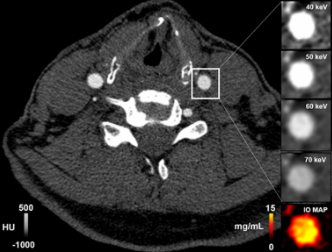
CAPL : Improved Diagnosis for Atheroma
CAPL
CAPL
Context :
Stroke is a major problem in today's health care system. They represent, indeed, the 2nd cause of cardiovascular mortality and are of ischemic origin, due to a narrowing of the arteries of the brain or clots which block the blood flow feeding the brain in 80% of cases. The 20% other cases are due to atheroma, the accumulation of various elements in the large arteries, mainly carotid arteries.
These fatty deposits in the neck arteries (carotid arteries) can form plaques that can lead to death or significant disability. Several treatments currently exist, ranging from diet modification to surgery and stenting, depending on the severity of the condition
For this reason, a cohort of researchers and radiologists have recently set up clinical trials to demonstrate improved diagnosis using new medical imaging techniques such as spectral photon counting CT (SPCCT) and dual energy CT (DECT).
Objective :
The objective here is to determine the effeciency of a new and more sophisticated imaging prototype, SPCCT, in characterizing the vulnerability of plaques in the neck arteries. To verify the analyses done with SPCCT and DECT, they will be compared with the analysis of plaques collected during surgery.
In vivo arterial phase SPCCT image of the carotid arteries

Status : In Progress
Included patients : 22*

